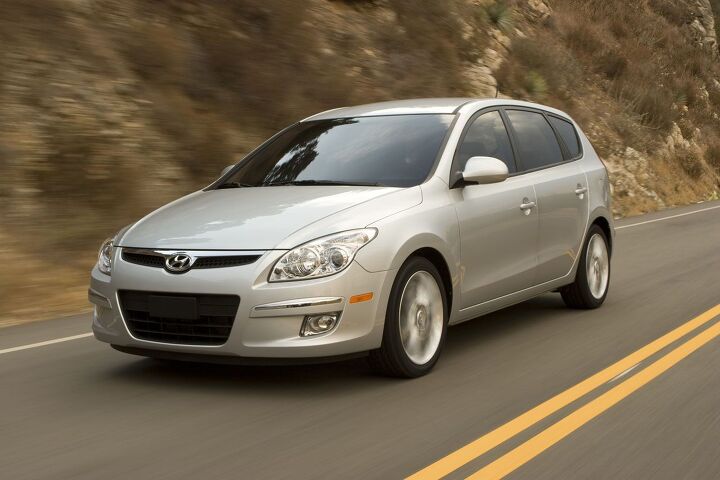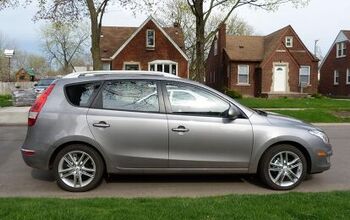Review: 2010 Hyundai Elantra Touring

In a very short time, Hyundai has made an amazing transformation from basket case to the automotive equivalent of a “nice girl”—dependable, easy to live with, and undemanding. But can Hyundai get its nice girls to do tequila shots and dance on tables from time to time? The conventional wisdom was that the much-heralded Genesis sedan and coupe would be the Hyundais that buck the trend, but they were variations on the same old Hyundai theme. As it turns out, the rebel Hyundai is an unlikely one—the Elantra Touring, a five door hatchback version of the Elantra sedan. Unlike the sedan, which has all the excitement of C-SPAN, the European-developed Touring has the same eager, quick-to-corner, drive-me-until-I-cry-uncle feel that you normally find in a Mazda 3, with the interior space of a midsize sedan and hatchback practicality tossed in as part of the deal.
Aside from some slick-looking 17-inch chrome-trimmed alloys, you wouldn’t know from looking at it that the Touring wants to have fun. It’s a tall-boy five-door hatchback, à la Scion xB and Toyota Matrix, albeit one that’s been super-sized. There are some neat styling touches, like the aforementioned wheels, and a Volvo-esque taillight treatment, but otherwise, the Elantra Touring’s styling restates a familiar theme.
Inside, a simple but stylish interface greets the driver; the seating position is high, as in a Ford Focus, with excellent sight lines all around. Simple, no-nonsense instrumentation and ergonomics highlight the interior, which is tastefully trimmed in high-quality, soft-touch materials that wouldn’t look out of place in a Volkswagen. Workmanship inside and out was notably high quality, with tight panel fits and a neat, well-sorted look.
Like most Hyundais, the Touring is comprehensively equipped: in addition to the stuff you expect (power windows and locks, cruise control, etc.), the test vehicle featured a power moonroof, heated seats, a useful multifunction trip computer, a short-throw B&M 5-speed, and an integrated satellite-ready radio. Two especially neat features: an optional ($325) hands-free Bluetooth system and a standard USB/iPod interface that allows the user to control the external device from the dash-mounted sound system. For the record, these two items alone cost about $1,000 on the average BMW.
The Touring’s interior features an overabundance of charcoal-colored trim, but the large, glassy greenhouse lends a light, airy feel. Rear seat passengers are treated to a well-shaped seat
with vast headroom and legroom—more legroom, in fact, than the midsize Sonata. The rear seats feature a 60/40 split, and fold down fully; the molded-plastic rear floor folds up to reveal a padded, segmented storage area. All this would make the Touring an excellent weekend companion for family getaways or trips to Home Depot.
Fire up the Touring, and you’re greeted with an eager growl from the 2.0-liter, 138 hp four-banger, which is shared with the sedan. The engine features variable valve timing, and revs eagerly, but it feels a bit overwhelmed with the Touring’s 3,080-pound curb weight, and the thrumming under the hood reminds you where Hyundai didn’t spend its money. On the other hand, the B&M hort-throw shifter is a real pleasure to use, and the powertrain returned excellent fuel economy, even under spirited driving—the standard trip computer indicated a very respectable average 29 mpg.
Driven hard, the Touring reveals its European-designed roots with quick, linear steering, minimal body roll (especially for a vehicle this tall) and an eager attitude. The ride is somewhat firm but never harsh. On the highway, the Touring takes a firm, direct set, tracking straight as a laser. At higher speeds, some mechanical noise intrudes, but wind noise is minimal, and the seats are comfortable and supportive. Overall, this would be a fine vacation hauler for a young family. Taken as a whole, the Touring’s dynamic qualities are reminiscent of a Volkswagen Jetta or Mazda 3, and it’s light-years better than its dull-as-dishwater sedan cousin.
Of course, the Touring is a Hyundai, so it’s going to be value-priced—$19,625 for the fully-loaded example I drove. A comparably equipped Mazda 3 will run at least three grand more. And the surprises keep coming here. Hyundai resale values have improved to the point where the Touring can actually be leased.
All this adds up to a pretty compelling package—a spacious, well-equipped, practical, fun-to-drive runabout with plenty of attitude. And if the Touring is underpowered, at least it doesn’t know it. Here’s hoping this is the first of many Hyundais to add driving pleasure to its value proposition.

More by FreedMike
Latest Car Reviews
Read moreLatest Product Reviews
Read moreRecent Comments
- Ltcmgm78 It depends on whether or not the union is a help or a hindrance to the manufacturer and workers. A union isn't needed if the manufacturer takes care of its workers.
- Honda1 Unions were needed back in the early days, not needed know. There are plenty of rules and regulations and government agencies that keep companies in line. It's just a money grad and nothing more. Fain is a punk!
- 1995 SC If the necessary number of employees vote to unionize then yes, they should be unionized. That's how it works.
- Sobhuza Trooper That Dave Thomas fella sounds like the kind of twit who is oh-so-quick to tell us how easy and fun the bus is for any and all of your personal transportation needs. The time to get to and from the bus stop is never a concern. The time waiting for the bus is never a concern. The time waiting for a connection (if there is one) is never a concern. The weather is never a concern. Whatever you might be carrying or intend to purchase is never a concern. Nope, Boo Cars! Yeah Buses! Buses rule!Needless to say, these twits don't actual take the damn bus.
- MaintenanceCosts Nobody here seems to acknowledge that there are multiple use cases for cars.Some people spend all their time driving all over the country and need every mile and minute of time savings. ICE cars are better for them right now.Some people only drive locally and fly when they travel. For them, there's probably a range number that works, and they don't really need more. For the uses for which we use our EV, that would be around 150 miles. The other thing about a low range requirement is it can make 120V charging viable. If you don't drive more than an average of about 40 miles/day, you can probably get enough electrons through a wall outlet. We spent over two years charging our Bolt only through 120V, while our house was getting rebuilt, and never had an issue.Those are extremes. There are all sorts of use cases in between, which probably represent the majority of drivers. For some users, what's needed is more range. But I think for most users, what's needed is better charging. Retrofit apartment garages like Tim's with 240V outlets at every spot. Install more L3 chargers in supermarket parking lots and alongside gas stations. Make chargers that work like Tesla Superchargers as ubiquitous as gas stations, and EV charging will not be an issue for most users.


































Comments
Join the conversation
One error in the review: The seats do not fold down "fully". To fold down "fully" would mean they go flat -as in flush with the rear storage area. They don't. Real bummer in the cargo area when seats don't fold down flat.
gettinold, maybe it's because my ET is a 2011 instead of a 2010, but the rear seats do indeed fold down flat. I have a bit of problem where the passenger side rear seat catches on the passenger front seat, but if I flip the front seat back forward for a second, the rear set goes all the way down. I'm 5'5" so the driver's seat is set further forward and I don't have this problem on the driver's-side rear seat...it just goes on down.